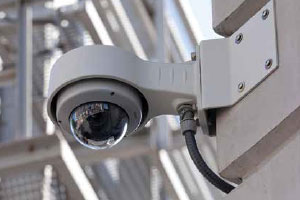
In the Eye of the Beholder
Full dimensional, 360-degree camera keeps eyes on the floor
- By Ralph C. Jensen
- Apr 01, 2013

When Graham Wallis walks into a Las Vegas casino, his first look isn’t to the slot
machines or gaming tables. He is thinking
about security and how his company can
improve surveillance for the end user.
Wallis is considering cameras that cover the entire playing
field with an overhead visualization—from end zone to end
zone. He is the CEO of Oncam Grandeye’s operations in the
United States.
“We believe 360-degree cameras have a future in the gaming
industry,” Wallis said. “We also want to play in such vertical
markets as maritime, retail, healthcare, school and hotels.”
Cruise ships have been using the Grandeye 360-degree camera
for quite a while now, to achieve complete situational awareness,
which means that monitors can see down corridors and where
people are going. The gaming vertical also believes in situational
awareness across the entire gaming platform, where monitors can zoom into a
particular scene or area and have a better look at various activities.
So, when Wallis enters the MGM Aria in Las Vegas, he is probably in search
of Ted Whiting, MGM’s security director, who understands surveillance as well as
anyone in the market.
“The camera is the enabler that gathers the information,” Wallis said. “With the
camera, we have installed analytics for each section of the gaming floor. The camera
is now the vehicle that tracks people in situational awareness, and it provides
real-time interrogation.”
Whiting knows a thing or two about the gaming industry. He started in 1989,
working his way up from a dealer to cage cashier to poker room brush. Whiting
has experience working the floor and knows what to look for so his employer, the
security end user, isn’t taken advantage of. In 2001, he worked in surveillance at the
Mirage Casino and Resort, and was later named the director.
 Whiting’s experience at the Mirage set him up for a once-in-a-lifetime opportunity
in 2006 when he was hired to create the surveillance system at the multi-billion-dollar CityCenter resort while the MGM Aria Resort and Casino was being
constructed. In 2009, opportunity knocked again when he was asked to design its
surveillance system, too.
Whiting’s experience at the Mirage set him up for a once-in-a-lifetime opportunity
in 2006 when he was hired to create the surveillance system at the multi-billion-dollar CityCenter resort while the MGM Aria Resort and Casino was being
constructed. In 2009, opportunity knocked again when he was asked to design its
surveillance system, too.
Somewhere along the line, Whiting and Wallis connected and began talking
about the Oncam Grandeye 360-degree camera.
“Video coverage is it,” Whiting said. “Without the coverage, all you have is ‘I
said/you said.’”
Whiting is sold on the 360-degree cameras and has installed them at the Aria.
He said that a 360-degree field of view allows his staff to spot a cheat from across
the gaming floor at one vantage point, then track that person to a choke point, or narrow pathway. It is at these choke points that high-definition cameras are able to “put a face on the person.” Not only that, the recorded video from the
360-degree camera allows Whiting and his team to track a criminal back in time,
enabling identification. The two cameras work in tandem to achieve the common
goal identification.
“If recorded video shows a cheat using a player’s card earlier in the day, we can
find the name, address and phone number,” Whiting said. “If a theft is reported at an
ATM, we can use the approximate time to identify the suspect via the ATM cameras,
and then use the 360-degree camera to track the suspect through the resort.”
Surveillance at the Aria isn’t exactly easy. The surveillance department is responsible
for 4,004 guest rooms and more than 150,000-square feet of gaming
space. Whiting boasts one of the Las Vegas Strip’s best track records at catching
cheats and thieves, and he and his staff are constantly on the lookout for new ways
to trump the gaming system.
“I’m always on the prowl for new technologies to outsmart the criminal element
in the gaming world,” Whiting said. “Whatever [technologies] I want, that’s what
we’re getting.”
Whiting’s choice of the Oncam Grandeye includes software through which images
from the 360-degree camera are de-warped, providing a clear view of a suspect’s
features. It also allows surveillance team members to conduct simultaneous
review of recorded video from various workstations in the surveillance command
center, within the 360 degrees.
The surveillance team manages more than 1,100 cameras in the casino that include
35 chokepoint cameras and fifty, 360-degree cameras. Whiting said that one
360-degree camera will replace four, or maybe five, PTZ cameras. This is not only
more cost effective but eliminates blind spots.
“We catch people doing bad things, and we catch them because we love doing
this,” Whiting said. “You talk about Big Brother, well, that’s what we do here. Surveillance
is our job and we want to do it well.”
The Aria surveillance team works hand-in-hand with the resort’s security team,
who also relies on a separate system. Both teams require a skill set for the casino’s
gaming floor. The various casinos on the Las Vegas Strip also abide by one
standard surveillance, and often help each other out when it comes to cheats and
criminals. There used to be 10 different properties on the Strip, with 10 different
standards; thankfully, that has changed.
Much has changed in the security and surveillance market over the years. Wallis
has seen it all, so when he stepped into the starring role at Oncam Grandeye, he
faced the task of bringing a start-up company into the 21st century.
Wallis said the company isn’t a typical integrator. They don’t work with end
users directly but will assist other systems integrators in developing solutions to
particular problems, especially if they want 360-degree technology.
“If you have a problem developing a solution, we come in with our version of
how to solve that situation,” Wallis said. “We have been successful in Europe, the
Middle East and Africa. We are just now bringing our philosophy to the United
States. The 360-degree is known, just not very well understood.”
Wallis understands the business that casino surveillance operators face, and
knows full well how security technology can ease that burden.
Taking a walk through a casino with Wallis is an exercise in
security education 101. He knows the entire playing field, and
knows where to throw for a touchdown.
This article originally appeared in the April 2013 issue of Security Today.